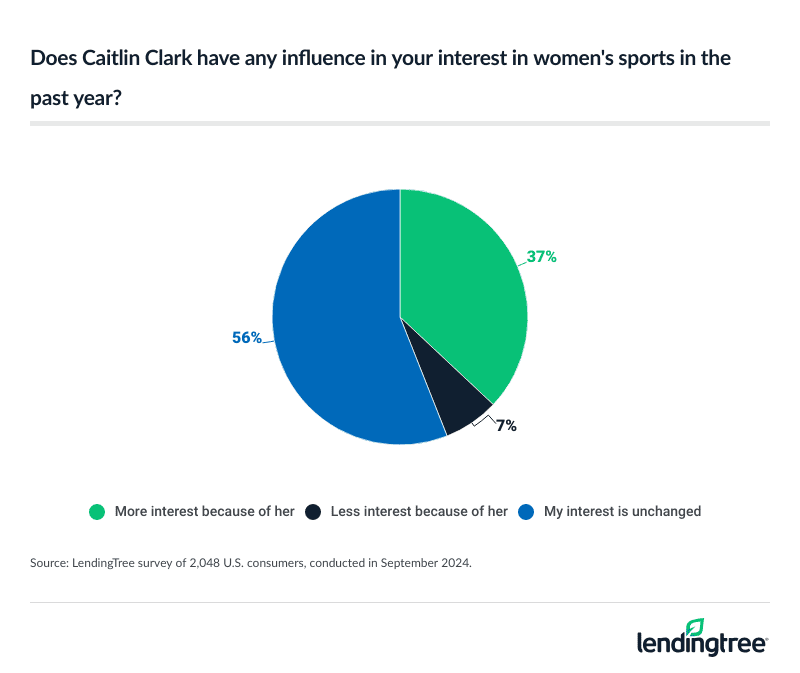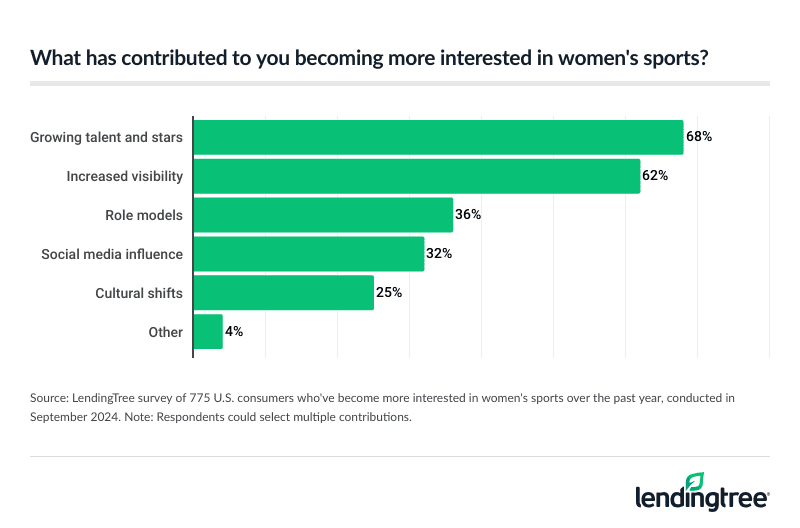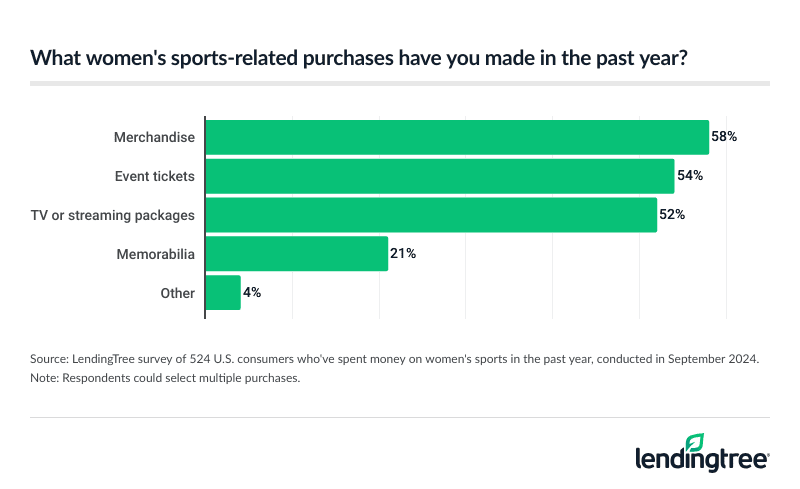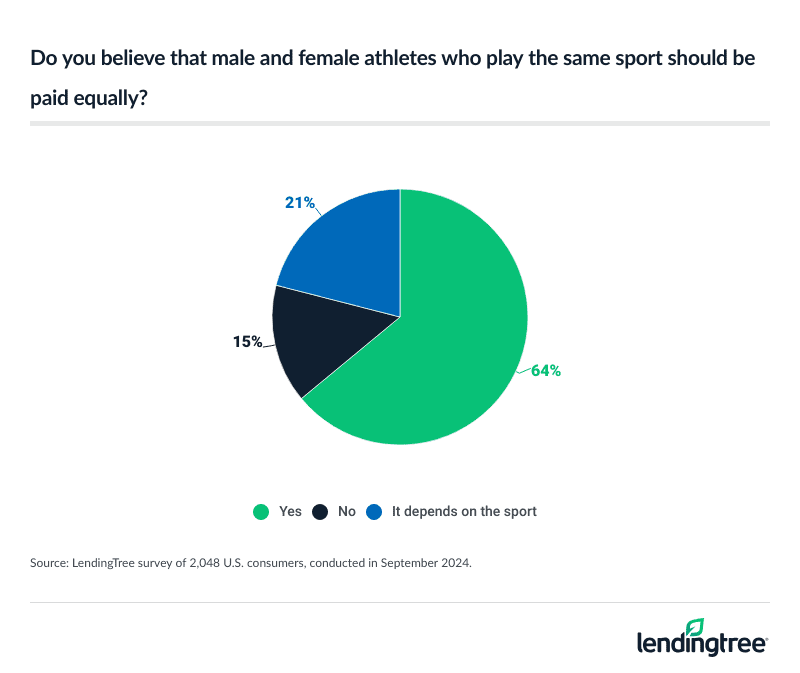38% Grew Interest in Women’s Sports in Past Year, With Many Crediting Caitlin Clark and Summer Olympics
Nearly 4 in 10 Americans say their interest in women’s sports has increased in the past year, according to a new LendingTree survey. And the more money you make, the more likely you are to say so.
People are also putting their money where their fandom is, as more than 1 in 4 Americans say they’ve spent money on women’s sports in the past year, including merchandise, tickets, streaming packages and gambling.
Our survey found that basketball phenomenon Caitlin Clark is certainly one of the main drivers of women’s sports’ recent surge. However, she’s far from the only factor pushing women’s sports into the forefront like never before. In fact, 26% of respondents say their favorite team is a women’s sports team and 29% say their favorite athlete is a woman, with Clark joined by gymnast Simone Biles and tennis icon Serena Williams at the top.
Here’s more on what we found.
Key findings
- Interest in women’s sports is growing, especially among high-income Americans. 56% of Americans say they enjoy watching women’s professional or collegiate sports, and 38% say their interest has increased over the past year. The higher your household income, the more likely you are to say both these things. In fact, 71% of those making $100,000 or more a year say they enjoy watching women’s sports, while 53% in that income bracket say they’ve grown more interested in the past year.
- High-profile talent and current events boost popularity. Among those who’ve gained interest in women’s sports in the past year, 68% say it’s due to growing talent and stars. Separately, 37% of Americans say their recent interest has increased due to Caitlin Clark. (Nearly 3 in 10 respondents say their favorite athlete is a woman, led by Clark, Biles and Williams.) Meanwhile, 53% of those who tuned into women’s events at this year’s Olympics say that influenced their fandom.
- Sports fans are putting their money where their mouth is on women’s athletics. More than 1 in 4 Americans have spent money on women’s sports in the past year, with 58% of this group spending on merchandise, 54% on event tickets and 52% on TV or streaming packages. Higher-income Americans are more likely to say they’ve spent. Additionally, 54% of those who’ve spent money on women’s sports this year gambled on them, including 62% of men.
- Women are evening the playing field, even on pay expectations. When asked which gender they enjoy watching more, 46% of Americans said both equally, followed by 43% opting for men’s sports and 11% for women’s sports. Overall, 64% of Americans think male and female athletes who play the same sport should be paid equally.
Interest in women’s sports shot higher in past year
Women’s sports are on the rise. This survey leaves no doubt of that.
More than half (56%) of Americans say they enjoy watching women’s professional or collegiate sports. That includes 65% of men, 64% of millennials (ages 28 to 43) and 61% of Gen Zers (ages 18 to 27). Those numbers are lower among older generations, at 51% of Gen Xers (ages 44 to 59) and 45% of baby boomers (ages 60 to 78), but this affinity among younger Americans bodes well for the future of women’s sports in this country.
So does the fact that higher-income Americans are more likely to say they enjoy watching women’s sports — 71% of those making $100,000 or more, versus 42% of those making less than $30,000.
Want further proof that the future seems bright for women’s sports? Nearly 4 in 10 Americans (38%) say their interest in women’s sports has grown over the past year. Almost half of men (48%) say so, as do 46% of parents with kids younger than 18.
The younger you are, the more likely you are to say you’ve gotten more interested in women’s sports in the past year. Nearly half of Gen Zers agree (48%), versus 43% of millennials, 34% of Gen Xers and 29% of boomers. Also, the more money you make, the more likely you are to say your interest in women’s sports has grown — 53% of those making $100,000 or more a year, versus 25% of those making less than $30,000.
This growing interest in women’s sports isn’t casual for many fans, either. Our survey found that more than 1 in 4 Americans (26%) say their favorite sports team is a women’s team, and 29% of Americans say their favorite athlete is a woman. Men are slightly more likely than women (30% versus 28%) to say their favorite athlete is a woman. Millennials are the most likely age group to say so (39%, versus 18% of boomers).
Star power, current events driving popularity
When asked to name their favorite athlete, one name clearly stood above the rest: Caitlin Clark. Nearly 4 in 10 Americans (37%) say they have more interest in women’s sports in the past year because of her. That includes 52% of those making $100,000 or more per year, 49% of men and 43% of parents with young kids.

Still, Clark is far from the only popular choice for favorite athletes. Two legends considered the greatest ever in their sports — Simone Biles and Serena Williams — aren’t far behind. Current WNBA stars A’ja Wilson, Angel Reese and Brittney Griner also received a significant number of votes, as did Olympic stars Sha’Carri Richardson and Katie Ledecky.
That collection of names is clearly a big reason why people are being drawn more to women’s sports, our survey found. Nearly 7 in 10 of those who say they’ve grown more interested in women’s sports say it’s because of the growing talent and stars in these sports. The second most common reason is simple: increased visibility. There have never been more women’s college and pro sports to watch, and it’s never been easier to watch. Judging by our survey, most who tune in like what they see and want more.

The survey showed the 2024 Summer Olympics helped drive some of this new interest. More than half (53%) of those who said they watched women’s events at the Olympics say it influenced them to start supporting more women’s sports. The fact that so many of the women mentioned as people’s favorite athletes were highly visible in the Olympics — Clark being a notable exception — isn’t a coincidence.
Fans putting their money where their mouth is
In a survey filled with good news for those who love women’s sports, perhaps none of the numbers matters more than this: 26% of Americans say they’ve spent money on women’s sports in the past year. The more money someone has, the more likely they are to have done so.
That’s a big deal. Sports leagues at all levels need money to survive. Social media buzz and watercooler talk is great, but cold, hard cash is what matters. Our survey shows that a significant number of Americans who earn the most are spending theirs on women’s sports.
Perhaps not surprisingly, merchandise, tickets and TV or streaming packages are the most commonly purchased items.

Men are significantly more likely than women (32% to 20%) to have spent on women’s sports in the past year. Younger Americans are far more likely than older ones to have done so (39% of millennials and 35% of Gen Zers versus 19% of Gen Xers and 8% of boomers). But most importantly, 43% of those making $100,000 or more a year say they’ve spent on women’s sports in the past year. Most businesses love to have high-income Americans as customers because, well, higher income often means more expendable income, and more expendable income often means more shopping.
People aren’t just buying jerseys and tickets, though. Among those who’ve spent on women’s sports in the past year, more than half (54%) gambled on them. That includes 62% of men and 64% of Gen Zers.
Women evening the playing field, even when it comes to pay
Nearly half (46%) of respondents say they enjoy watching men’s and women’s sports equally. Women are more likely than men to say so (50% versus 41%), while millennials (49%) and Gen Xers (48%) are more likely than boomers (41%) and Gen Zers (38%).
Looking at just those who say they enjoy watching sports, 39% say they enjoy both equally, with 50% saying they prefer men’s sports and 11% preferring women’s sports.
There’s greater agreement when it comes to pay expectations. Nearly two-thirds of Americans (64%) say they believe male and female athletes who play the same sport should be paid equally. About 1 in 5 (21%) say it depends on the sport, while just 15% flatly say no.

Women, not surprisingly, are far more likely than men to agree with equal pay, with 73% of women and 55% of men saying so. Still, the fact that more than half of men agree is noteworthy. Gen Zers (53%) are significantly less likely than other age groups to agree (Gen Xers are most likely at 70%). Also, the highest-income Americans are tied as the least likely to agree, but even 62% of that group backs the idea of equal pay.
Of course, that doesn’t mean anyone should expect, for example, the average WNBA player to make the same salary as the average NBA player anytime soon. The economics of the two leagues are too different. However, at a minimum, this survey seems to hint at a desire among Americans to see female athletes become far better paid than they are today.
Don’t fan yourself into long-term debt
Few things ignite Americans’ passions like sports. Men’s, women’s, college, pro, high school — even Little League — sports unite communities like few things in this country can. People who might come to blows if they start talking about politics or money or other issues will hug and high-five each other over a big win or console each other after a devastating loss.
But it isn’t cheap to follow that passion. There are practically an unlimited number of ways you can spend to support your team, and millions of Americans take on significant debt in doing so.
Again, a little bit. Every once in a while.
Here are some tips to help follow your sports fan passion without spending yourself into too much debt.
- Budget for it. If you love it and you spend a bunch of money on it — whatever it may be — it should have a place in your budget. That’s true whether it’s travel, dining out, shopping or women’s sports. Including that passion helps you manage your spending on it while allowing you to enjoy it.
- Leverage credit card rewards. The right credit card, used wisely, can help you extend your sports budget. Cards can help you earn free (or at least reduced-cost) hotel nights, airfares, tanks of gas and other perks that can help with costs. Some cards can even offer you exclusive fan experiences and access to discounts that you might not be able to get elsewhere. Or, at a minimum, a simple cash back card can get you 1% to 2% back on everything you buy, and a little bit can go a long way.
- Keep your options open. This isn’t breaking news, but where you see a game matters when it comes to cost. For example, it may be cool to go to New York to see Clark and the Indiana Fever take on Breanna Stewart and Sabrina Ionescu and the WNBA champion Liberty, but it might be way cheaper to see her play in Dallas or Phoenix depending on where you live.
- Remember that you don’t always need “new.” Sports teams of all kinds are very, very good at providing fun, interesting things to spend on all the time. While it might be tempting to upgrade your favorite team’s jersey every year, for example, chances are your old one is probably fine. Plus, that old jersey is just more proof that you’re not just some new bandwagon fan, and that has to be worth something, too, right?
Methodology
LendingTree commissioned QuestionPro to conduct an online survey of 2,048 U.S. consumers ages 18 to 78 from Sept. 13 to 17, 2024. The survey was administered using a nonprobability-based sample, and quotas were used to ensure the sample base represented the overall population. Researchers reviewed all responses for quality control.
We defined generations as the following ages in 2024:
- Generation Z: 18 to 27
- Millennial: 28 to 43
- Generation X: 44 to 59
- Baby boomer: 60 to 78
The content above is not provided by any issuer. Any opinions expressed are those of LendingTree alone and have not been reviewed, approved, or otherwise endorsed by any issuer. The offers and/or promotions mentioned above may have changed, expired, or are no longer available. Check the issuer's website for more details.
